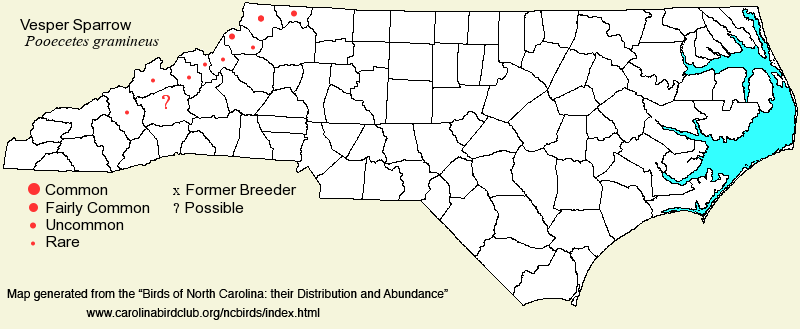 |  |
|
Vesper Sparrow - Pooecetes gramineus PASSERELLIDAE Members: | Search Common: Search Scientific: |
|
|
|||||||
| General Comments | The Vesper Sparrow, a species in its own genus, has a wide breeding range, from the Western states east to the Atlantic Coast. However, the eastern populations are strongly declining, owing to loss of grassy field and meadow habitat; Western populations are faring better, and the birds are much more common in the Western and Midwestern grasslands. Vesper Sparrows nest south in the East only to the North Carolina mountains, and they winter essentially in the Atlantic and Gulf Coastal Plain regions. Over most of the state, it is simply a spring and fall migrant, and an uncommon one at that. Breeding birds inhabit mid- to high elevation pastures and grassy knolls, almost always in hilly situations and frequently well back from roads; scattered rocks and small trees are often used as singing perches. Wintering birds occur mainly in sandy fields and weedy croplands, generally where the grasses are not dense and there is some bare ground; they often occur with Savannah Sparrows. Migrants are usually found in pastures and other short-grass habitats. Though the breeding population has not obviously declined in the state, the migrant and wintering populations are way down from those of former decades, when flocks numbering 20 or more birds could be seen in migration. In fact, Pearson et al. (1942) stated that the species "is a common winter visitor in open fields in most parts of the State." | ||||||
| Breeding Status | Breeder | ||||||
| NC BRC List | Definitive | ||||||
| State Status | SC | ||||||
| U.S. Status | |||||||
| State Rank | S2B,S2N | ||||||
| Global Rank | G5 | ||||||
| Coastal Plain | Winter resident and transient; strongly declining. In winter, formerly fairly common in the southern coastal counties, and west to the Sandhills; now uncommon in these areas. Rare in the remainder of the region, and typically does not now overwinter in the northern half of the region. In migration, rare to uncommon over the region. Mainly mid-Oct to mid-Apr. One photographed along the coast at Pea Island NWR on 12 May 2023 was very late for the province. Peak counts: ? A report of 15 birds, with one carrying food, at Wilmington on 16 Jul 1952 (Chat) must be either a misprint or mis-identification, and is certainly incorrect. | ||||||
| Piedmont | Transient, and sparse and local winter resident; strongly declining. In winter, rare to very uncommon in the extreme southern portions, mainly in the Charlotte to Shelby areas; very rare into early winter in the eastern and central portions, but does not overwinter there; casual in winter in the foothills area. In migration, formerly uncommon to occasionally fairly common, but now quite uncommon in both spring and fall. Mainly mid-Mar to mid-Apr, and late Oct to mid-Nov. One reported at Elkin on 20 Jun 1954. Peak counts: 50, Cleveland, 2 Feb 1986. | ||||||
| Mountains | Summer resident and transient; declining in summer and in migration. In summer, rare to uncommon and very local, mainly on grassy balds and other high elevation pastures (above 4,000 feet); rare down to about 3,000 feet. Nests southwest to the Newfound Mountains (Max Patch area), mainly in areas close to the Tennessee border. In migration, mostly rare to uncommon (formerly uncommon) over most of the region. Very rare in winter in lower elevations, but normally does not overwinter. However, up to four spent the winter of 2023-24 at Swannanoa (Buncombe), seen from 1 Jan - 19 Feb. Mainly mid-Mar to mid-Nov. Peak counts: | ||||||
| Finding Tips |
Breeding birds are usually well away from roads and require some hiking to reach, such as at Pond Mountain in Ashe. Rich Mountain Road, between Snake Mountain and Rich Mountain, in northern Watauga, is usually reliable, and a few can often be found along the Appalachian Trail east of Carvers Gap. The birds are too unpredictable in migration and winter to offer particular sites. ** to *** | ||||||
| Attribution | LeGrand[2025-10-24], LeGrand[2024-11-08], LeGrand[2024-05-14] | ||||||
| NC Map Map depicts all counties with a report (transient or resident) for the species. | Click on county for list of all known species. |
| NC Breeding Season Map Map depicts assumed breeding season abundance for the species. |  |